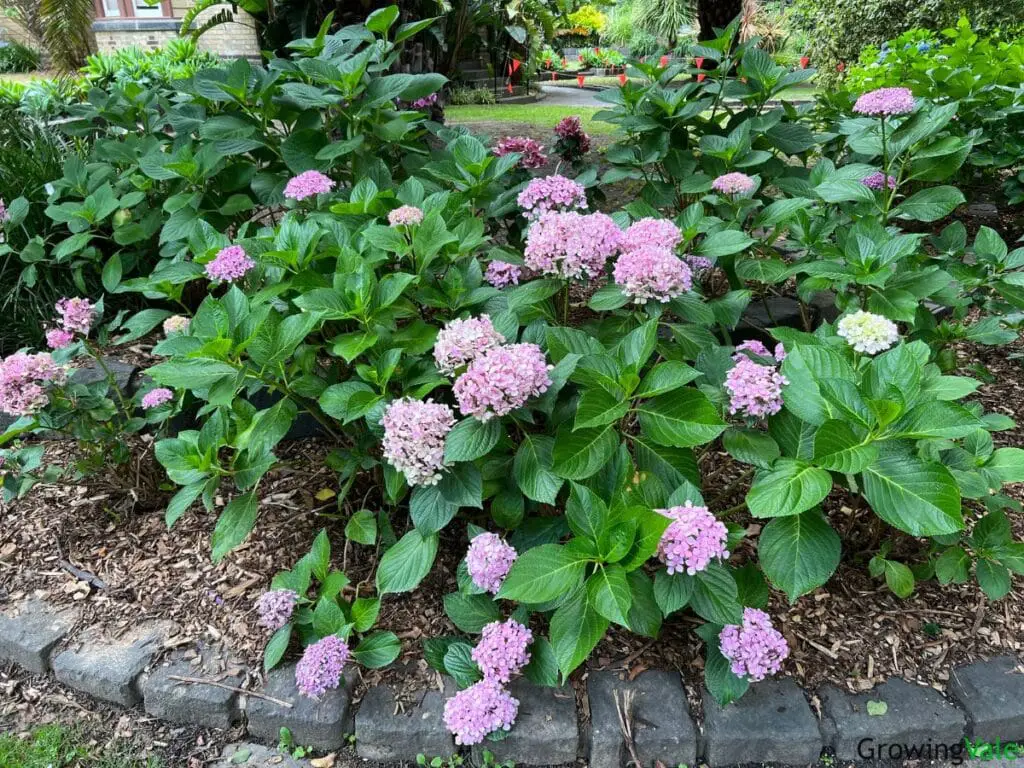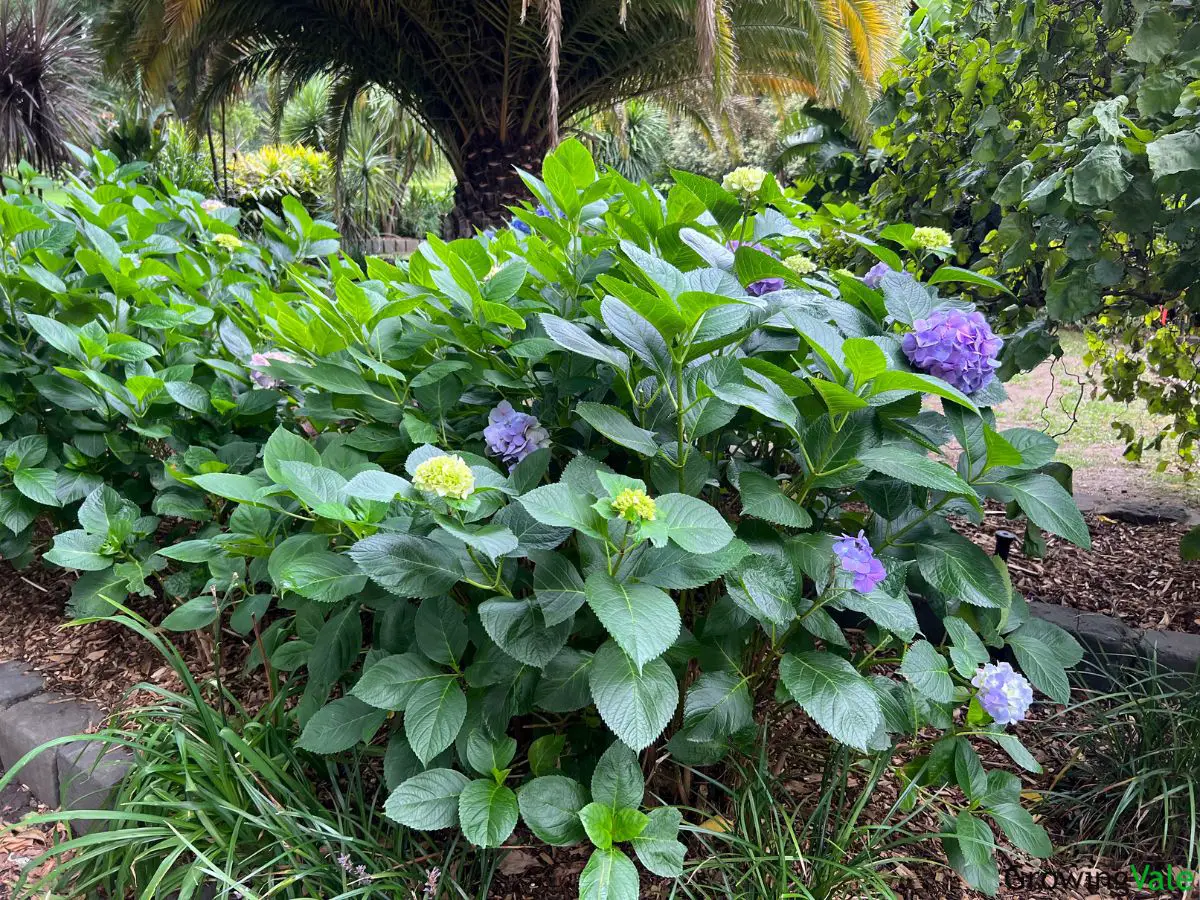Nothing shouts summer louder than the spectacular blooms of the mophead hydrangea. For so long, these hydrangea shrubs have been and still remain a gardener’s favorite.
With so many varieties and cultivars to choose from, there is definitely a hydrangea for your growing space, whether it is large or small, in shade or sun.
But you don’t just want one shrub in your garden, even if it does offer up a floral display like no other. You need to plant other shrubs or perennials alongside.
Growing plants that work together is how landscapers get the most benefit from the spaces available to them.
Choosing Plants to Grow Alongside Hydrangeas
Plan carefully before you rush off and buy some more plants. Remember that some hydrangeas have the potential to grow very large, so make sure you know which type you have, and how large it is likely to grow. For instance, climbing hydrangeas can reach 30 feet (9.14 meters) in height!
Fortunately, not all grow so large in either height or width, and you can keep your hydrangea in check by regular pruning, providing it is done at the right time of year.
Some varieties and cultivars of hydrangeas that you can grow with other pairing plants and flowers include:
- Bobo hydrangea
- Little lime hydrangea
- Limelight hydrangea
- Oak leaf hydrangea
- Little quick fire hydrangea
- Endless summer hydrangea
- Annabelle hydrangea
- Ruby slippers hydrangea
- Twist and shout hydrangea
- Quick fire hydrangea
- Tiny tuff stuff hydrangea
- Vanilla strawberry hydrangea
- Summer crush hydrangea
- Incrediball hydrangea
- Pinky winky hydrangea
- Fire and ice hydrangea
When you have decided on the plants you want, you should make sure that their growing conditions are compatible with those of the hydrangea. This means thinking about the soil, sunlight, and moisture requirements.

Here are the ideal growing conditions for hydrangeas:
Sunshine
Your hydrangea needs protection from the heat of the afternoon sun but still requires around five hours of morning sunshine, otherwise, you will not have many flowers.
Soil
Well draining, and slightly acidic soil, enriched with organic matter, is best for growing hydrangeas.
Water & Fertilizer
Hydrangea plants of all types need regular watering at ground level.
Fertilizers designed for acid-loving plants can be applied early in the growing season but should be avoided after the middle of the summer.

Successful Companion Plants to Grow with Hydrangea For Every Purpose
Once you have identified plants with similar growing requirements to hydrangeas, you can consider where you are planting and decide upon the best species to select.
Here are some companion plants for hydrangea for different scenarios:
For Hedging, Paths, or Division of Spaces
If you are using Hydrangea macrophylla as a hedging plant, you may wish to consider planting some shade-loving or shade-tolerant plants in front of the hydrangea shrub.
You can select either flowering plants such as the tall foxglove or low-growing pansies. Alternatively, you could select a plant grown for its attractive foliage to contrast with the hydrangea.
If you are growing a shorter hydrangea as a hedging plant, then consider using climbing roses as the background plant – they will love the sunshine too.
Companion Planting for Container Grown Hydrangeas
Hydrangeas have become a popular container-grown plant because they are so easy to care for!
Certain cultivars have been developed to be slow-growing and these will retain a naturally rounded shape with flowers that can be shown off well in a pot.
Because the soil in pots dries out quicker than it does in the ground, frequent watering will be required. It’s also important that the container-grown hydrangea is not sited in a position where it will be subject to the strength of the hot, afternoon sun. Equally important is to make sure that the hydrangea is planted in well-draining soil.
Because pot-grown hydrangeas do best if planted in a large container, there is often space to fill around the base of the shrub.
Also, because the hydrangea does not look very attractive during its dormant period, some carefully selected planting can keep some winter color and seasonal interest. Choose a perennial with attractive foliage that doesn’t grow too large or that can be cut back as desired.
Variegated species, such as ivies, are easy to grow and can be trimmed easily, so they do not take too much of the goodness from the growing medium.
Small ferns can be a perfect choice to grow alongside a pot-grown hydrangea, as they will not grow large and will retain an attractive shape. Their foliage will give a superb contrast against the large flowers of the hydrangea. Ferns will bring interest to the patio or deck all year round.
Background plant
If you choose a taller variety of hydrangea shrub, its flowers and large leaves will make a perfect background plant in a mixed herbaceous border and will show off your other perennials.
Winter pansies can make a show of color when the hydrangea has lost all its leaves and only has woody stems to offer.
Perennials to Grow with Hydrangeas
If you are looking for flowering border hydrangea companion plants, there are a few options.
In a woodland setting, rhododendrons and azaleas are also acid-loving plants and will thrive next to hydrangeas. They will also bring early-season color to your border.
Using Flowers
As well as perennials, you can consider using annual flowers such as impatiens in the front of your border. They are low-growing and will liven up the border when the hydrangea has finished flowering.
Using Foliage
Hostas are a very good choice of shade-tolerant perennial that will provide plenty of floral and foliage interest. With so many to choose from, hostas can be one color, zonal or variegated. They are a splendid choice of companion, eye-catching perennials to grow with hydrangeas.
Ornamental grasses, as well as ferns, will provide a good contrast when planted with hydrangeas.
You can select silver or pink flowering grasses that will rustle gently in a summer breeze. Many ornamental grasses will change color as their seed heads mature and are also a good choice for dried flower arrangements.
Ferns provide architectural interest and are available in many shades, sizes, and forms.
Shrubbery
When you consider that the hydrangea will provide you with a magnificent summer display, you may wish to consider planting it alongside other shrubs with different flowering seasons.
Rhododendrons and azaleas flower in the spring and because they are also acid-loving plants, make an excellent choice of companion for the hydrangea. Their flowers will have finished before the hydrangea comes into bloom.
Hollies and ivies too are good choices, both of which are available in the variegated form, adding to the color interest in their decorative foliage.
What Not to Grow with Hydrangeas
Plants that like full sun, and those that do not like regular watering, are not sensible choices of companion plants to grow with hydrangeas. Similarly, hydrangea shrubs are acid-loving, so you should avoid plants that are not.
Plants with silver-green foliage have a tendency to be plants that do not require frequent watering and do best in full sun. Lavenders are an example of a bad companion plant that is not a good choice to grow with hydrangeas.
Conclusion
By adding a companion for your hydrangea, you will lengthen the season of interest in your garden and will get the most from your hydrangea. And best of all, the suggested companion plants are all easy to grow and very low maintenance!

